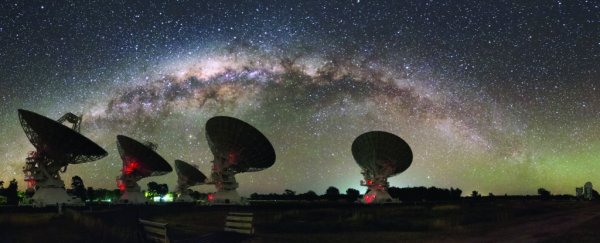Fast radio bursts are quite the ongoing space mystery. We don't know what they are, and only a couple of dozen sources have ever been detected by radio telescopes.
But they may not be as rare as we think - they could be firing off as frequently as once a second over the entire observable universe.
"If we are right about such a high rate of FRBs happening at any given time, you can imagine the sky is filled with flashes like paparazzi taking photos of a celebrity," said lead researcher Anastasia Fialkov of the Harvard-Smithsonian Center for Astrophysics.
"Instead of the light we can see with our eyes, these flashes come in radio waves."
Most fast radio burst sources are only detected once. They are extremely powerful radio bursts that last just milliseconds. They can't be predicted, and because they are so short and unrepeating, tracking them to their source or trying to figure out what causes them is all but impossible.
However, there's one notable exception. FRB 121102, which was first detected in 2002. It has fired an incredible 34 bursts over the years, which has allowed researchers to pin down its location to a galaxy 3 billion light-years away.
In August this year, researchers from the University of California, Berkeley announced that they had detected a massive 15 FRBs in just five hours from FRB 121102.
We still don't know what that means, but Fialkov and her co-researcher Avi Loeb wondered: What if FRB 121102 is not an outlier at all, but representative of all FRBs?
According to their model, low-frequency telescopes could detect FRBs between 50MHz and 3.5GHz once a second per sky, especially accounting for future telescopes.
The Australian Square Kilometre Array Pathfinder, for instance, was only switched on this year, and has already detected three of the mysterious signals operating at a quarter of its capacity.
The Square Kilometre Array, being built across Australia, New Zealand and South Africa, will be much more powerful, and will also include a low-frequency aperture array that will be able to detect the very low frequency signals between 50 and 350MHz.
"In the time it takes you to drink a cup of coffee, hundreds of FRBs may have gone off somewhere in the Universe," Loeb said. "If we can study even a fraction of those well enough, we should be able to unravel their origin."
There are several theories as to what causes FRBs. Black holes or neutron stars, for instance. They could be pulsars, but pulsars are typically regular, as far as we know. Or they could be caused by magnetars, a type of neutron star with a very powerful magnetic field, known to emit giant flares.
Some researchers have even hypothesised that they could be alien spaceships.
Whatever they are, they could, the researchers say, help unveil clues as to the origin of the universe and the Epoch of Reonisation, wherein the interstellar medium, primarily hydrogen, became ionised in the very early universe. We still don't know how that happened, either.
"FRBs are like incredibly powerful flashlights that we think can penetrate this fog [of the interstellar medium] and be seen over vast distances," said Fialkov. "This could allow us to study the 'dawn' of the universe in a new way."
The research has been published in the peer-review journal The Astrophysical Journal Letters. and is available on Arxiv here.
